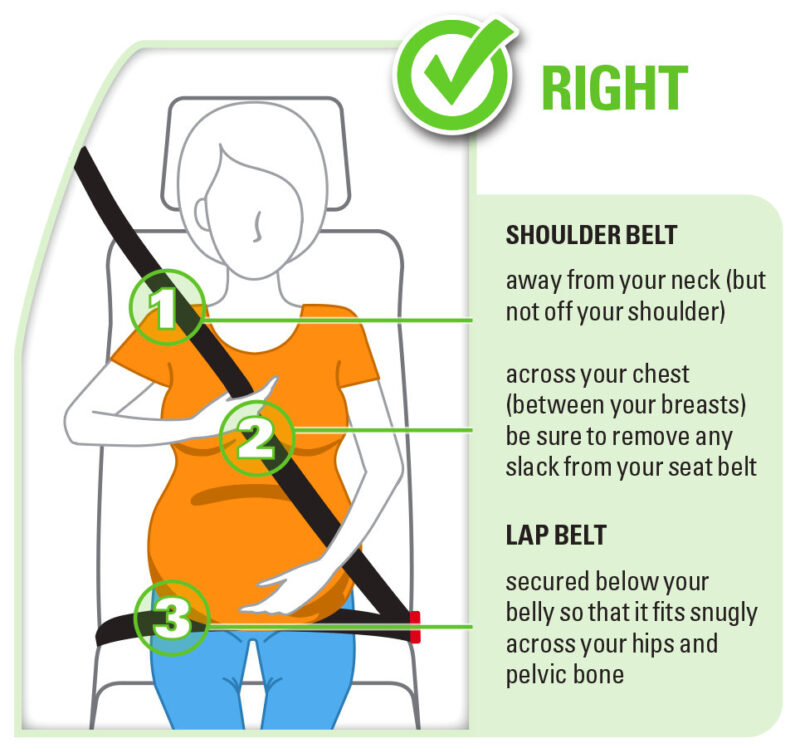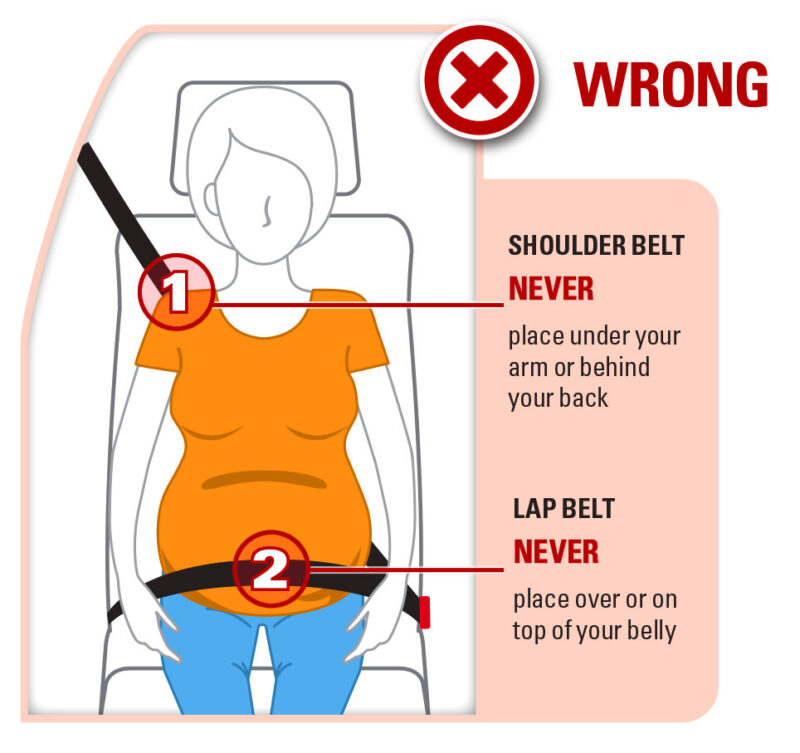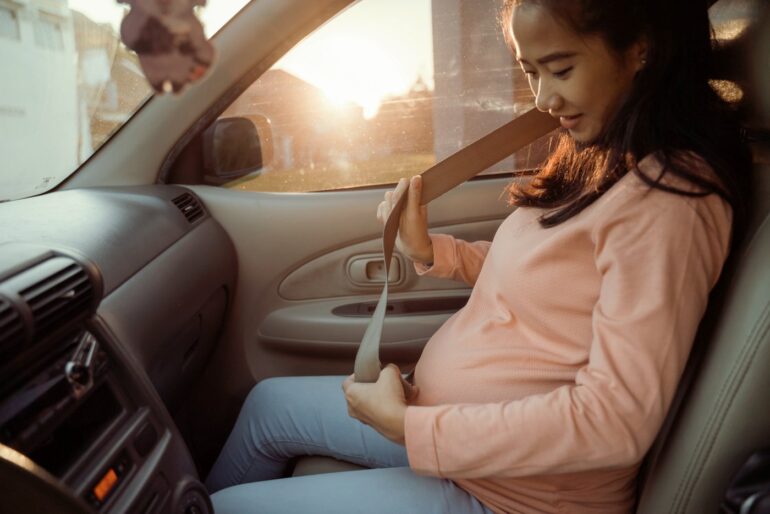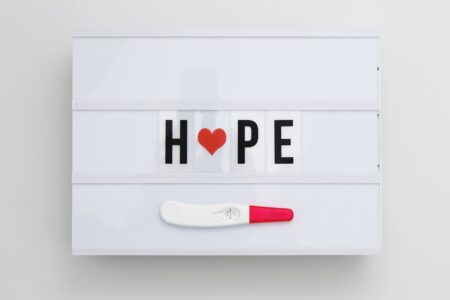Should you wear a seat belt during pregnancy? And if so, how?
So do you really need to wear a seatbelt during pregnancy? They aren’t very comfortable, can be awkward to use when your belly is huge, and don’t always fit very well — not to mention that a lot of pregnant women worry that the belt itself could injure the baby in the event of a car crash.
But when it comes to pregnancy seat belt safety, doctors, researchers and accident investigators all agree: The best way for a pregnant woman to protect her baby in utero is to protect herself.
So when you’re on the road, wear your seatbelt every time — and that means throughout your entire pregnancy (and even if it’s a little uncomfortable sometimes).
There are good reasons to always play it safe. A 2014 study published in the American Family Physician medical journal found that trauma complicates one in 12 pregnancies — and of those traumatic injuries, motor vehicle crashes were the cause of nearly half.
Are seatbelts & airbags really safe for pregnant women?
In a study evaluating pregnancy seat belt safety, a group of researchers led by Dr Stacie Zelman from Wake Forest University examined a national database of over two million injured patients, and found over 2,400 pregnant women injured in car crashes.
Women wearing a seat belt, having an airbag, or both were significantly less likely to have pregnancy-related complications than women with neither a seat belt nor an airbag. (Not surprisingly, the combination of a seat belt and airbag resulted in the lowest rate of complications.)
There is no evidence that safety belts increase the chance of injury to the fetus, uterus, or placenta — no matter how severe the collision — agrees the South Dakota Department of Health. Your wee one is protected within a fluid-filled sac, inside the uterus… and the uterus is protected by bones, organs and muscles.
In fact, they say that fetal injury due to pressure from the safety belt is rare, occurring in fewer than 1 out of 10,000 car crashes. The bottom line when it comes to pregnancy seat belt safety: Pregnant women should use seat belts with confidence that they will help, not hurt, in case of a car accident.

How to safely wear a seat belt when you’re pregnant
So how exactly do you properly use a car’s seat belt during pregnancy? Here are step-by-step directions to maximize pregnancy seat belt safety.
1) Start by moving the front seat as far back as possible and adjust the seat’s position as needed. (Your breastbone should be at least 10 inches from the steering wheel or dashboard.)
2) If possible, adjust the steering wheel so it is up and away from your abdomen. Make sure it is angled toward your breastbone, not your belly or head.
3) Sitting as upright as possible, place the lap belt so it fits snugly under your belly and as low on your hips as possible (so it pulls against your pelvic bones, not your abdomen).
4) Position the shoulder belt across your chest (between your breasts) and over the mid-portion of your collar bone (away from your neck).
5) Fasten and adjust the seatbelt so it fits as snugly as possible. (If the seatbelt isn’t big enough, consider getting a seatbelt extender online or from your auto dealership.) Pull any slack (looseness) out of the belt.
6) Remember to adjust your belt and positioning as you grow, always making sure to keep as much distance from the steering wheel as possible — and at least 10 inches — between the wheel and your breastbone — while still allowing you to reach the pedals and steer properly.
The American College of Obstetricians and Gynecologists (ACOG) suggests that expectant moms should always wear a lap and shoulder belt every time they travel during pregnancy for the best protection — even in the final weeks of pregnancy.
Never slip the shoulder belt under your arm or behind your back — always make sure it is placed across your chest and fits between your breasts, and let the top part of the shoulder belt rest across your shoulder (but not against your neck). If you need to, adjust the height of the top of the seatbelt on the post between the front and back doors.


MORE: Turn your favorite jeans into maternity pants with this smart & simple DIY pregnancy hack
If your car has an on-off airbag disabling switch, should you turn it off?
No — leave it on. The National Highway Traffic Safety Administration (NHTSA) and doctors recommend that pregnant women wear seat belts and leave airbags turned on. Seat belts and airbags work together to provide the best protection for you and your baby.
One more reminder
Pregnancy seat belt and airbag safety are two key ways to protect your baby when you’re in the car. Now is also the time to get into some better driving habits, particularly in terms of avoiding distracted driving.
That means be smart and safe — don’t talk on the phone, don’t send/read texts, don’t look at your phone’s GPS, and don’t blast the music to 11 as you play air guitar — while you’re driving any vehicle.
Pregnancy seat belt safety: A story of survival
We’ll leave you with a true-life tale — a reminder that even if you’re the best driver in the world… accidents happen.
Laura from Ohio experienced a life-threatening car accident, and went into labor shortly afterward. Both she and the baby survived — a miracle.
I was 37 weeks and not showing any signs of delivering soon (although I was ready). I was driving 55, and I popped a hill and there was a truck in my lane. I hit him head-on with the majority of the impact being to my front corner. I was scared that I was bleeding or my water had broken… They had to use the jaws of life to cut me out.
It took the medic all the way across my belly to find the heartbeat, but it was strong when he finally found it. I was then transported to a hospital 45 minutes away, which is the trauma center for our area. It is also where I was scheduled to give birth. When I got to the hospital, the first thing they did was get the heartbeat on the Doppler. That was the best sound I have ever heard.
Safe travels!
ALSO SEE: How pregnancy can change your shoe size





